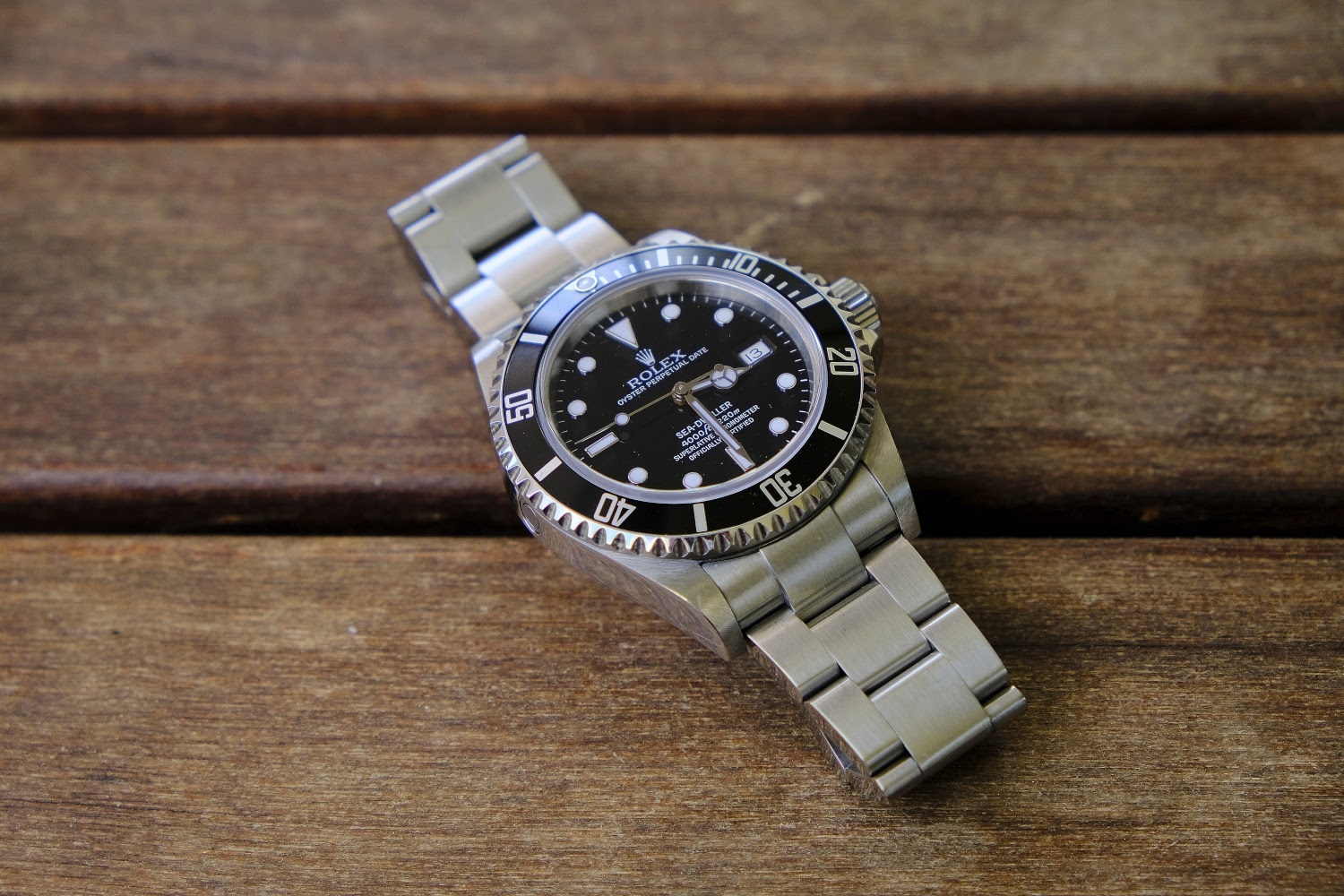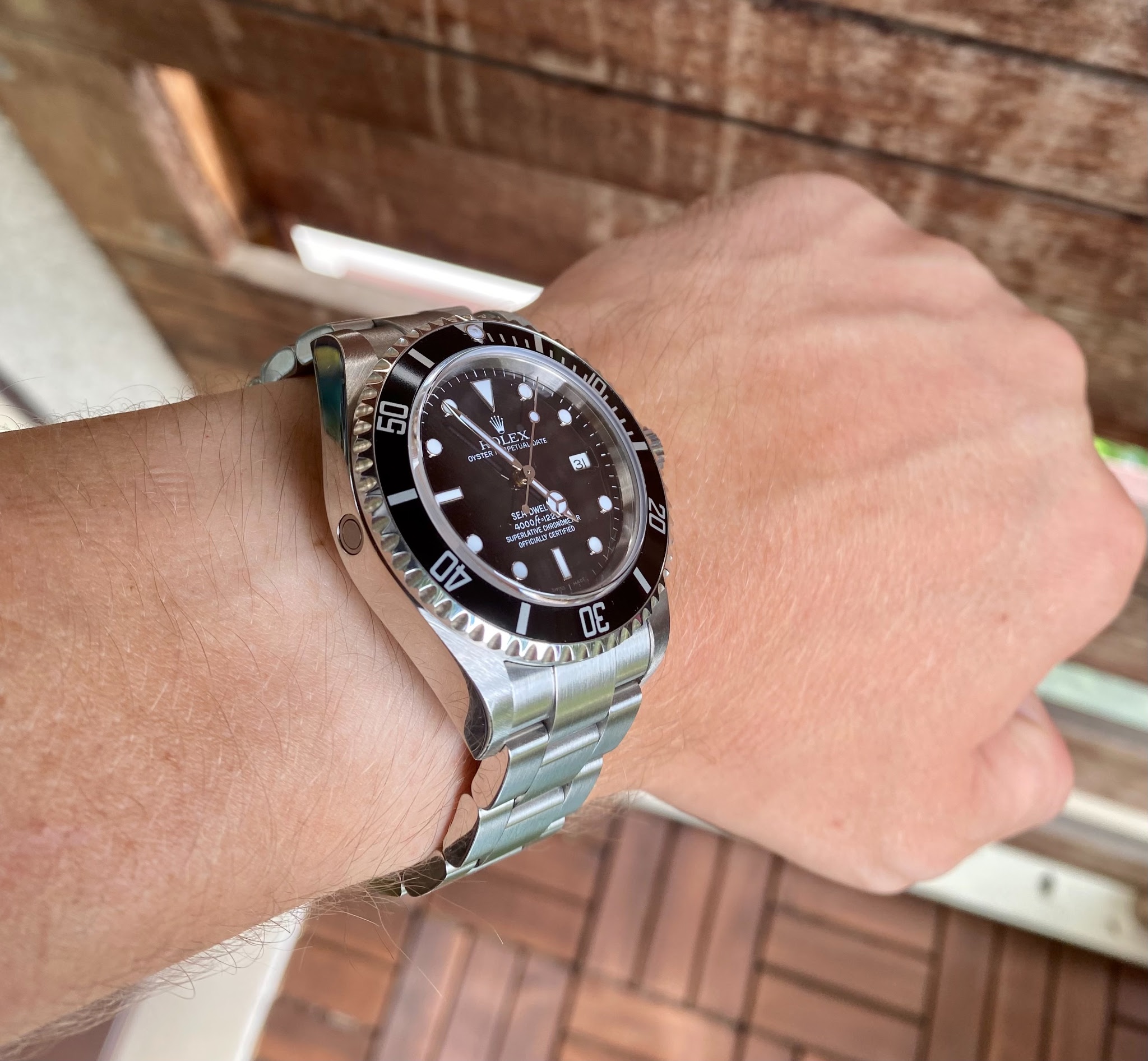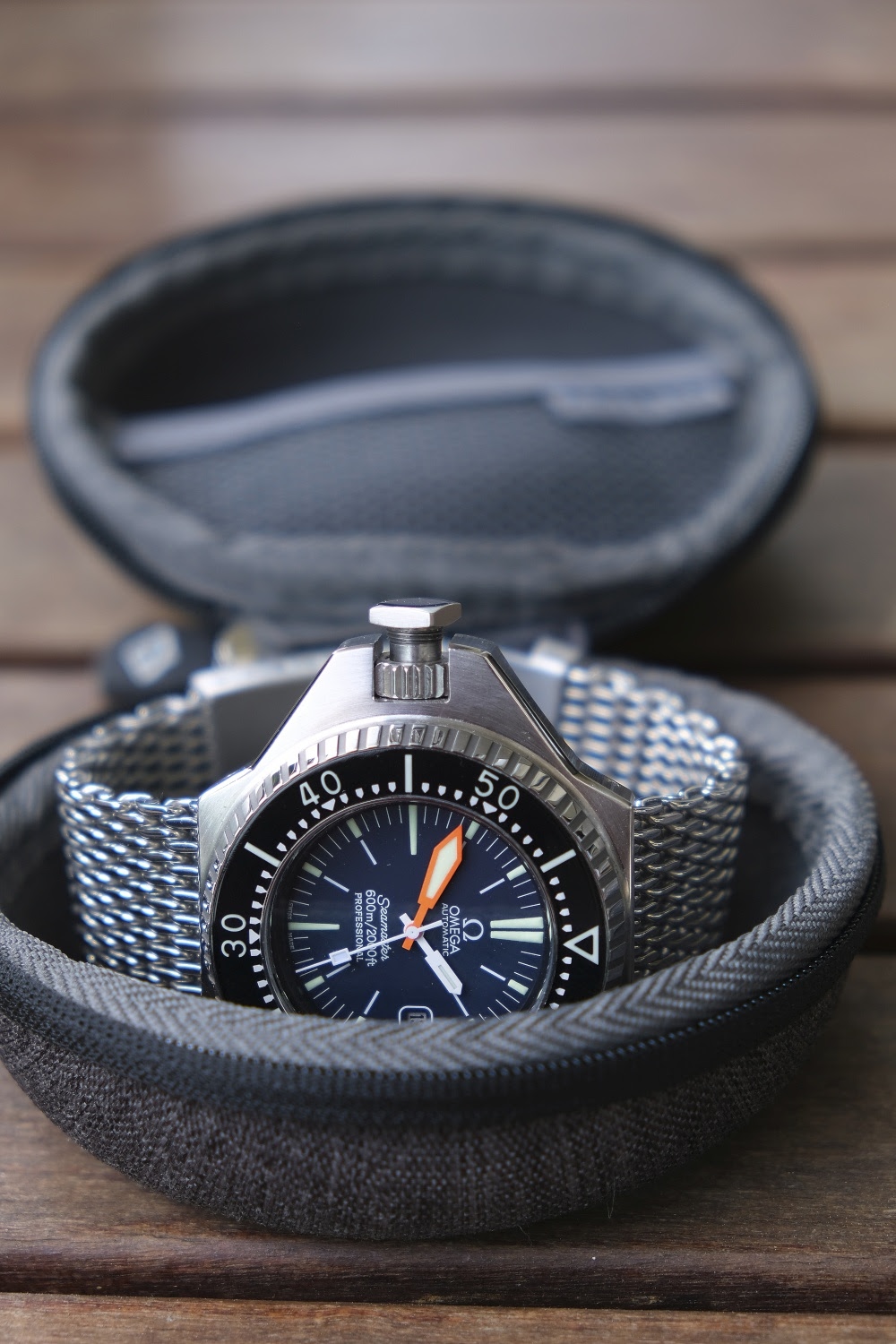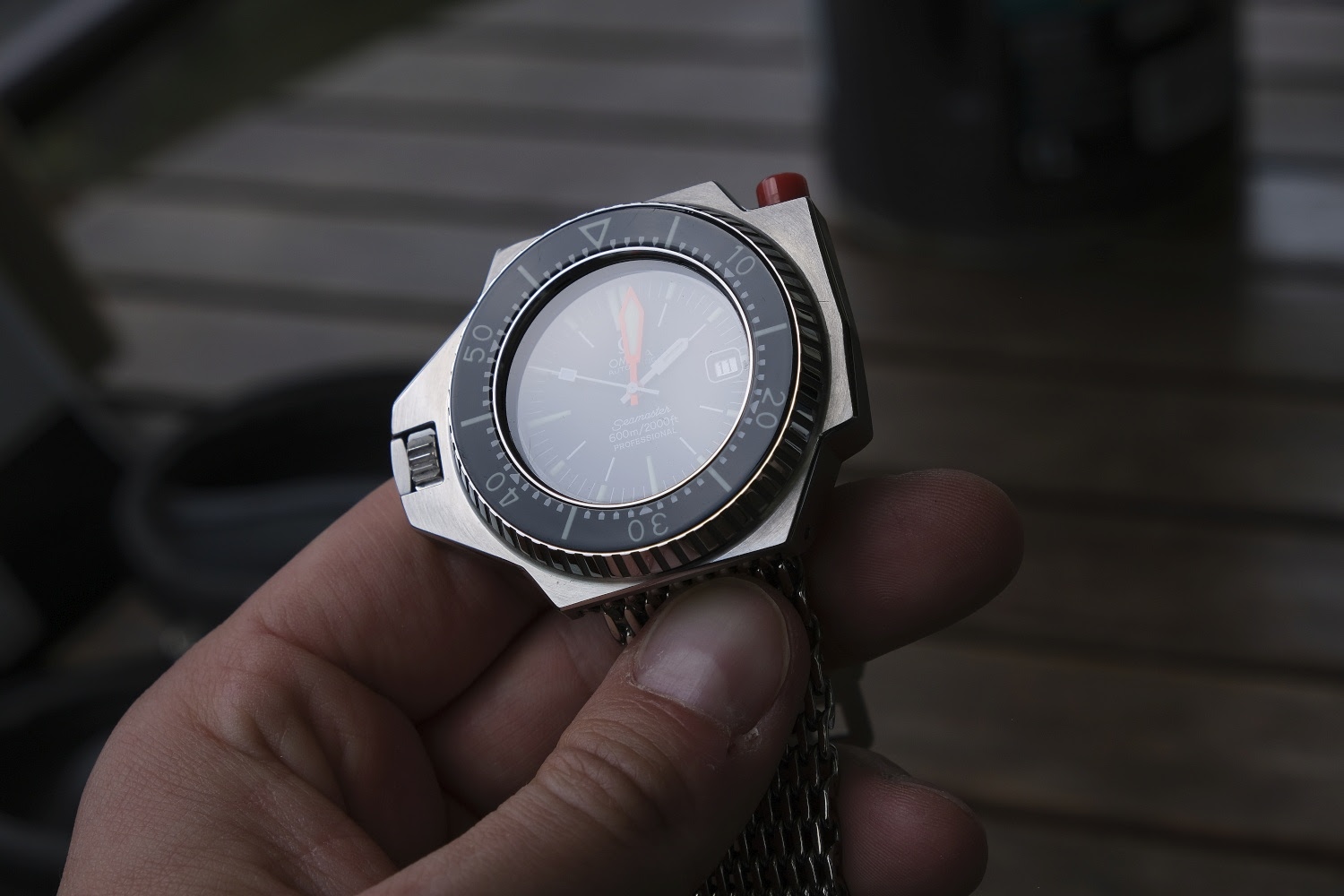Gargamel
42

Iconic Saturation Divers
I’m beginning to get the hang of the collection concept.
I’ve always refused to line up the miniatures in a display case, to accumulate comics read only once in a bookshelf or worse, to bring back sand from each of my trips.
And yet despite my desire for eclecticism I find myself with a majority of divers among my watches and I recently added a timepiece ( arghhh I hate this stupid expression) essential to form what represents for me the perfect triptych of professional diving icons.

Far be it from me to go looking for fragile grannies full
of tritium on the dial and hands. No, I think I’ve got a perfect trio there.
Each of us knows why we’re drawn to mechanical
watches. Family memories, film memories, an attraction to micromechanics or the
reminder that, before they were useless pieces of men jewelry, watches were sometimes tools
meeting very specific specifications.
In this case, while waterproof watches met a
need for everyone and solved a recurring problem, diving watches were necessary
for the successfully completion of a dive and were indispensable for the
advancement of underwater exploration. And so, of course, did the evolution of
diving equipment and decompression studies.
In the early 60s, saturation diving was introduced.
This consists of having divers live in pressurized (or hyperbaric) chambers at
the same pressure as the work zone.
Throughout this period, divers will breathe
special air containing helium and hydrogen in addition to oxygen, so that they
can withstand the effects of pressure on their bodies. This is not a problem as
long as the diver remains in the pressurized environment. However, during ascent,
divers must respect decompression stops in order to reduce nitrogen and helium levels
in human tissues. The depth and time of each decompression stop vary depending
on the time spent underwater and the depth reached.
Heliums atoms are the smallest naturally
occuring gaseous particles on the planet, and can find their way everywhere,
including inside perfectly watertight watches. However, when helium bubbles
have managed to slip into the watch case, they become trapped inside the case
and a pressure difference develops between the air inside the dial and the air outside,
which can damage the watch and, in particular, blow out the crystal.
Saturation diving is mainly associated with
offshore practice on oil platforms. The working conditions for these divers
must be among the worst.
These two videos provide an insight into this
world:
www.youtube.com
www.youtube.com
Their missions last several days, sometimes up
to 1 month, during which they spend most of their time in a tiny chamber, then
go out to work for several hours in a wetsuit in often cold seas, up to 300
meters deep. Physical condition must be impeccable, and there is no room for
error..
It is impossible to exit the chamber without
undergoing decompression, which lasts several days. In case of an accident, the
emergency must be handled by the team itself. As a diver, survival is also
linked to the quality of the technical team's work on the surface. A mistake in
the procedure, a sudden drop in pressure, and it's immediate death for the
crew.
An idea of what a hyperbaric chamber looked like in the late 60s:

Extract from an article on Comex:
“ In France, the duration of a saturation
dive cannot exceed 30 days. The compression time of divers is short compared to
the decompression time. For a dive to 300 meters, divers will have to undergo
14 hours of compression and 10 days of decompression. »
A little reading: www.draeger.com
If the conditions are extreme even today, it
is reasonable to imagine that they were much worse in the 70s, the heyday of
offshore diving. Whether it's the habitat, the equipment, or the knowledge of
risks.
In short, whether to punctuate a saturation diver's workday or allow a professional diver to check his dive time and decompression stops, the watch was indispensable. It had to be particularly waterproof and robust.
It is all this universe and these extreme conditions that fascinate me.
The watches I am going to talk about are the result of fantastic engineering work in the late 60s aimed at designing watches capable of withstanding the constraints imposed by this new profession. Regarding the main constraint, two solutions were found: 1) Perfect helium resistance, 2) A workaround allowing this gas to escape without damaging the watch.
I do not claim to have flawless knowledge of the profession or watchmaking at the time.
If the first brand to have found a solution to helium presence in the watch is Doxa with the famous helium escape valve, Rolex is mostly remembered with the Sea-Dweller 1665 released in 1967.

Essentially, it is a Submariner to which a helium escape valve has been added, and perhaps a thicker crystal (to be confirmed). Nothing transcendent outside of this valve. And yet, it is an icon. Over the decades and subsequent versions, it is associated with Comex, a French company pioneering in underwater exploration.
Model of the valve found on the 16660 and 16600:

Mine, the first of the trio, is a Sea-Dweller 16600, the ultimate reference of 5-digit SDs and the last to have equipped Comex. Produced from 1988 to 2008, it is claimed to be waterproof to 1200m.

It bridges the gap between vintage Rolexes with 4 digits and the "luxury" generations with 6 digits. So, you have the charm of the old ones with the bevels, the thin crown guard, the aging aluminum insert, the somewhat light but nevertheless very sturdy bracelet, and the peace of mind of the modern ones with sapphire crystal and the slightly posh lacquered dial and 904L steel.
I won't go into technical details; I prefer to share my impressions.
Its thickness and the domed back make it a watch that is not necessarily very balanced on the wrist. A submariner from that era is comfortable, but this one takes some time to get used to. Beware, it remains light compared to today's standards and fits under a shirt (the ultimate test according to internet reviews).
It has, as they say, a strong presence but can still be considered an everyday watch. And it's crazy to think that it can survive crazy pressures in extreme conditions and, at the same time, accompany me to embassy receptions.

The second watch in my collection (sic) is another icon of professional diving. It even takes its name from it, the PloProf (short for professional diver).

Released in 1971 by Omega for exclusive professional use. It was conceived from a blank sheet unlike the previous one.

It's a real visual UFO. You either love it or hate it.
It addresses several issues. Regarding helium,
instead of letting it escape during decompression, Omega preferred to ensure
that it could not enter the watch. The fragility of the crown to impacts is
resolved by its left position and its integration into the case. Or is it the
case that surrounds the crown...

As for the risk of accidental movement of the bezel, this is solved here by a locking system that requires pressing the red button to turn it. Clever but not very practical. However, I can turn the bezel with one hand by pressing the button with my middle finger and then manipulating the bezel with my thumb and index finger.

This watch is called "monobloc," meaning the movement is inserted from the top, like the dial, hands, and everything else (gaskets and glass). The more pressure the watch receives, the more it contributes to its waterproofness.
Many vintage divers are declared non-waterproof by customer service due to the threaded rusted or deformed screw-down case back. Problem solved here.

There is often reference to the use of a specific alloy for this watch at the time, Uranus steel, which some associate with 904L due to the presence of molybdenum in its composition.
More info here: Omega Prototypes & Omega Ploprof
This watch is imposing, even frightening at first, but ultimately very portable and comfortable. Flat bottom, relatively short lug-to-lug length, and contained thickness and weight.
My watch is a bit special. Not its origin but its condition. This Ploprof has been completely refurbished in Bienne. Case, bracelet, bezel, dial, etc... Only the movement remained. I find it amazing that Omega continues to produce all the parts for a watch from the early 70s.


The dial is a beautiful deep blue, the acrylic bezel gives an effect similar to sapphire bezels, slightly less pronounced. A big advantage of this refurbishment is that it is perfectly waterproof, and the dial/hands/bezel set is quite luminous.
I love some finishing details like the grooved back allowing the watch to better grip on the wetsuit or the polished internal curves and angles of the case.


The third watch in this trio is the latest arrival. It is the Seiko Tuna SLA041, another evolution of the first Tuna.

Just like with the Ploprof, I've had my eye on the Tuna for a few years. The Tuna's story begins in 1968 when a Japanese professional diver comes to see Seiko to complain about his Seiko diver, which, according to him, is unusable. This is followed by an analysis of the problem (helium again, but not only) and a few years of work to release the 6159-7010.
All the details on this excellent article (in french): The True Story of the Tuna
What characterizes the Tuna is its helium resistance thanks to the L-shape of its gaskets and the monobloc case, but above all, the peripheral protection of the case, typical and almost unique to this watch.


Here again, function dictates form, and the Tuna responds to precise technical constraints. It was a real tool when it was released. And still is today!
Of the three, it is the only one that, in its current version, has not disguised itself to please a clientele looking for a status watch.
The current Sea-Dweller has adorned itself with fragile ceramic on the bezel and seeks to break waterproofing records for media pleasure. Omega chose simplicity on the modern Ploprof with the abandonment of the typical monobloc construction for a helium escape valve. Not to mention the thickness, weight, and fragility of the sapphire, then ceramic, bezel. So, it only retains the overall resemblance of the case.
Seiko has been producing the Tuna 1000m in quartz and automatic (even in Spring Drive) for many years now with roughly the same specifications as the very first one. And while prices have inevitably increased, a quartz S23631 costs around 2000€.
I find the solution chosen by Seiko on many of its divers and by Omega on this Ploprof 600 more beautiful than that of all the others, i.e., the helium escape valve. Rather than finding a way to manage the helium problem in the watch, it is better not to let it in. In other words, instead of finding a solution to a problem, let's avoid the problem.
Something tells me that the solution I like is also the most restrictive both in terms of industry, finance, and even for customer service.
Today, Rolex and Omega are competing for who has the biggest with the Deep-Sea Challenge (11000m) and the Ultra-Deep (6000m). The former uses a helium escape valve as usual, the latter does without it and doesn't really communicate about how this gas is managed.
Speaking of showing off, I loved this real-life test Seiko conducted in 2015.
They attached 4 Tunas to a bathyscaphe, 2 auto and 2 quartz. The models were randomly selected from production. And they descended everything to great depth. The quartz watch stopped at just over 3000 meters, and the auto at 4300 meters! The pressure applied to the glass eventually touched the second's hand. On ascent, the watches worked perfectly.
Seiko could have communicated like crazy; they could also have made a commemorative version of the exploit or increased the announced waterproofing to 3000m. But no. In a Japanese way. Classy.

Since I've been eyeing the Tuna, I could have caved half a dozen times. However, I was always held back by some details. The quartz movement, the gold theme, the too exaggerated tool watch aspect, or even the ugly hands of previous generations. This one, however, if not a real reissue of the original, takes some aesthetic codes and probably brings the best finish a Tuna has had so far.
The SBDX011, equipped with the 8L35 just like mine, next to the original 6159-7010. The resemblance of the SLA041 to the original is clear.

On this SLA041 as on its contemporaries, the bezel is ceramic and protects a titanium case, crown, and the bezel, which here is made of "ever-brilliant steel," an alloy very close to 904L apparently. So, there are 3 different materials on this watch!

Seiko started using this alloy on high-end models (the other two divers released at the same time as this one, for example, the SLA037 and SLA039, Seiko 55th Anniversary Limited) as well as on some Grand Seiko.
The insert is very similar to that of the SBDX001, a lacquered steel. It shines, it scratches, but it's sturdy and doesn't cost an arm to replace. Some have managed to polish out scratches with auto polish. I'll try it someday on the MM300, which I scratched beautifully in the first week of diving with it, and then no more scratches on the dozens of dives that followed.
The blue-gray dial is made of iron to provide
better magnetic resistance, and it is lightly lacquered when all the other Tuna
models have a matte dial. The finish deserves no criticism. I won't make the
classic remark about the dial shifting from blue to black because it's not
true. However, I find that it sometimes gives the impression of being light
gray and sometimes, when the light is scarce and buried under the thick
sapphire glass, it is midnight blue. In these moments, the insert usually turns
gray, the markings disappear, and the brushed hands jump out at us. In other
words, it plays with reflections, and I love that.

Moreover, the hands also return to their original shape and have a perfect size. I take, for example, the lollipop on the second hand, which is positioned right in the middle of the round indices it crosses—remarkable!
No Prospex markings on the dial, no X or S on the crown, and no reference to any anniversary on the back. The marketing team apparently did not have access to the design office, and that's a good thing. The accordion bracelet is also a creation of the brand during the release of the first Tuna. Its function is to allow the watch to stay in place when the diver descends, and his neoprene suit compresses with pressure. An idea that has been adopted by others since. Clever.
It is large and thick, but it is the lightest of the three. And the placement of the lugs as well as the flat bottom make it sit well.

I have here three amazing watches. An original with its 50 years but new, an almost vintage evolution now, and a modern evolution very faithful to the concept of its predecessor. They represent an era, an epic, the beginnings of professional offshore diving and deep depths. The golden age of mechanical watches before the arrival of dive computers.

Iconic Saturation Divers

Awesome article. Thank you so much for having taken the time to write and to share it.


My cocktail diver.

Wow, what a report!

As a watch aficionado and an ex recreational diver I’ve enjoyed the reading from top to bottom. Also I’ve learned new things, for example the
Lovely article!

